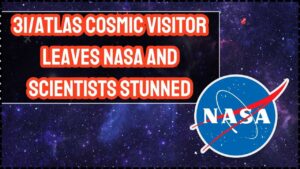3I/ATLAS Cosmic Visitor: Imagine a cosmic visitor streaking through space at mind-blowing speeds, coming from a star system millions of light-years away — that is exactly what 3I/ATLAS is doing right now. This interstellar comet has NASA scientists and astronomers everywhere buzzing with excitement, curiosity, and a touch of awe. Whether you’re a space enthusiast, a budding astronomer, or simply fascinated by the mysteries of the universe, this article is your go-to guide for understanding this incredible cosmic traveler with deep insights, facts, and expert knowledge.
Table of Contents
3I/ATLAS Cosmic Visitor
3I/ATLAS is a once-in-a-lifetime event — a remarkable visitor from the vastness beyond our solar system that’s challenging and expanding our cosmic knowledge. With every twitch of gas and puff of dust it releases, scientists glean new insights into distant star systems, the materials that create planets, and potentially the seeds of life. Whether you’re gazing through a telescope, following scientific updates, or simply curious about our place in the cosmos, 3I/ATLAS inspires awe and wonder. Its safe and spectacular journey reminds us of the universe’s endless mysteries, waiting for humanity to explore and understand. Stay tuned, look up, and enjoy this historic celestial performance—because the cosmos just sent us a fascinating message from a world beyond our own.
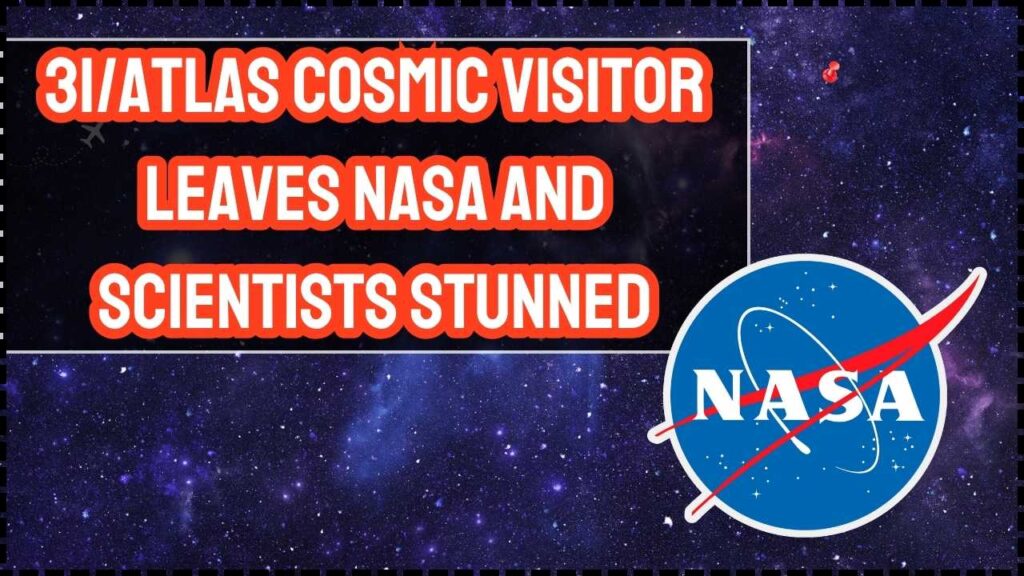
| Feature | Details |
|---|---|
| Discovery Date | July 1, 2025 |
| Origin | Interstellar (outside solar system) |
| Closest Approach to Sun | October 29-30, 2025, ~1.4 AU (just inside Mars orbit) |
| Speed | About 68 km/s relative to the Sun |
| Estimated Nucleus Size | Between 0.3 and 5.6 km, most likely under 1 km |
| Unique Features | High carbon dioxide, water vapor far from Sun, active gas jets |
| Official resource | NASA |
What Is 3I/ATLAS? — The Interstellar Comet From Beyond Our Solar Neighborhood
3I/ATLAS is not your everyday comet. The “3I” indicates it’s the third known interstellar object to enter our solar system, meaning it originated outside our sun’s family, somewhere in another star system far away. Unlike typical comets, which orbit the Sun in predictable elliptical paths, 3I/ATLAS travels on a hyperbolic trajectory—essentially a one-way trip through our neighborhood spanning millions of years.
Discovered by the Asteroid Terrestrial-Impact Last Alert System (ATLAS) telescope in Chile on July 1, 2025, this object was quickly identified thanks to archival observations from multiple telescopes worldwide dating back to May and June 2025. Moving at an astonishing 68 kilometers per second, it’s racing through space so swiftly that this brief visit offers a rare chance for scientists to study material from outside our solar genesis.
Why NASA and Scientists Are So Hyped About 3I/ATLAS Cosmic Visitor?
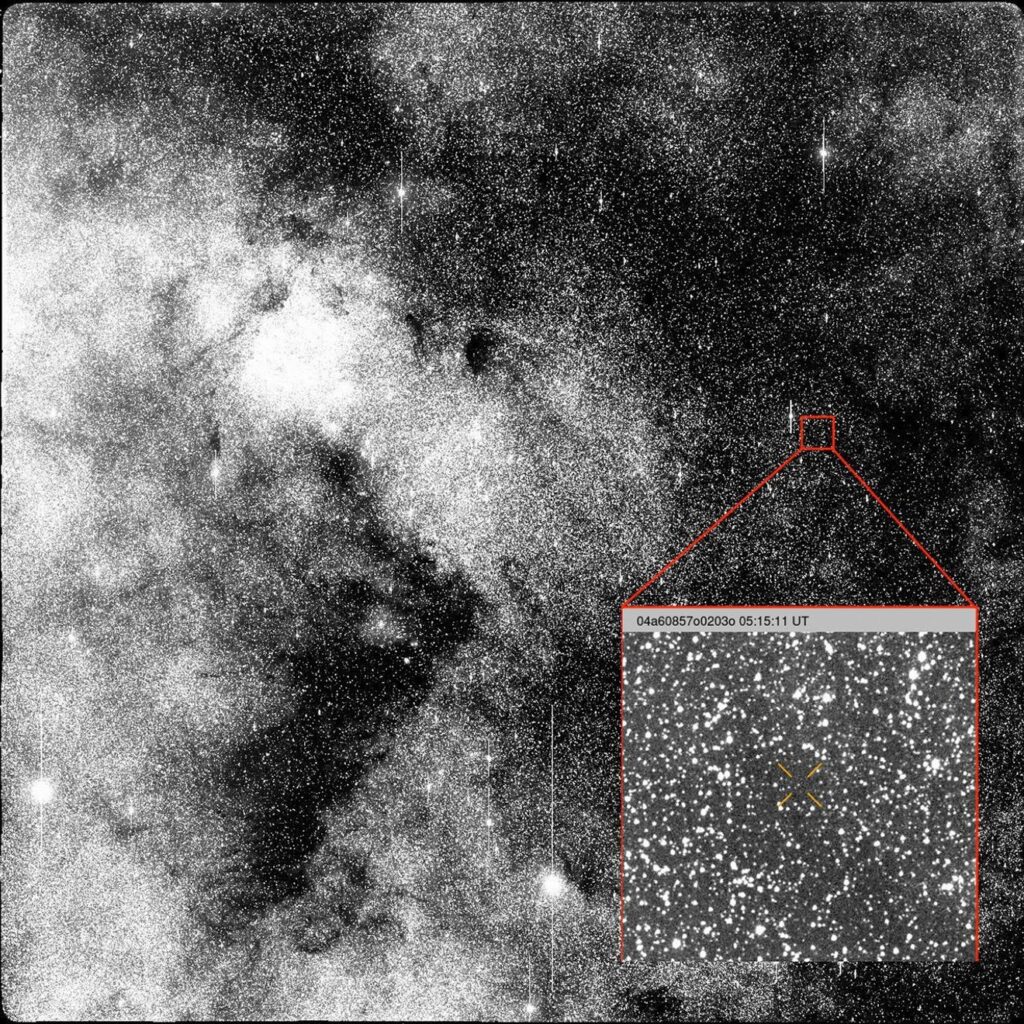
NASA and the global astronomy community are thrilled because 3I/ATLAS is unlike any comet we’ve previously studied. Most comets become active only once they get close to the Sun — heated enough to release gases like water vapor — but 3I/ATLAS surprised astronomers by showing significant activity even at 6.4 AU from the Sun (more than six times the Earth-Sun distance). This activity isn’t primarily water ice sublimation but involves carbon dioxide and other volatile compounds, including carbonyl sulfide and cyanide gases.
State-of-the-art telescopes like the James Webb Space Telescope and the Very Large Telescope (VLT) observed these unusual chemical signatures, indicating that 3I/ATLAS has a very different chemical makeup than most solar system comets. It’s also been ejecting dusty jets visible as giant geysers of gas and particles streaming away from the nucleus—a spectacular sight from Earth’s perspective.
The comet’s reddish coma indicates a mix of icy and dark organic material, similar but distinct from previous interstellar visitor 2I/Borisov. Long-term observations show this dust and gas cloud evolving, which helps scientists learn about the comet’s surface and internal chemistry as it reacts to solar radiation on its journey through our neighborhood.
The Discovery and Observations Journey — Worldwide Telescope Collaboration
The story of 3I/ATLAS began with the ATLAS telescope in Chile spotting the unusual object, quickly backed by “precovery” data from other observatories like the Zwicky Transient Facility in California and Weizmann Observatory. This rapid collaboration allowed astronomers to confirm its hyperbolic path, proving it came from beyond the solar system.
European Space Agency’s ExoMars Trace Gas Orbiter (TGO) and Mars Express spacecraft even captured images of the comet’s coma during its close approach to Mars in late September 2025. Meanwhile, Earth’s newest and most powerful facilities — including the Vera C. Rubin Observatory and NASA’s TESS satellite — provided detailed measurements of the comet’s brightness increase and activity before and during its journey.
NASA’s Transiting Exoplanet Survey Satellite (TESS) spotted 3I/ATLAS active in May 2025, when it was still very distant from the Sun, confirming early and ongoing sublimation of volatile ices other than water. Coordinated observations also recorded atomic nickel vapor and cyanide releases, offering unique insights into its composition.
The comet’s faintness — it won’t get brighter than apparent magnitude 11.5 — means it requires telescopes with at least 200-300 mm apertures to be visible. It passed solar conjunction on October 21, 2025, limiting Earth-based sightings right at its closest approach to the Sun, but can be tracked using satellites like NOAA’s GOES-19 and others orbiting Earth and Mars.
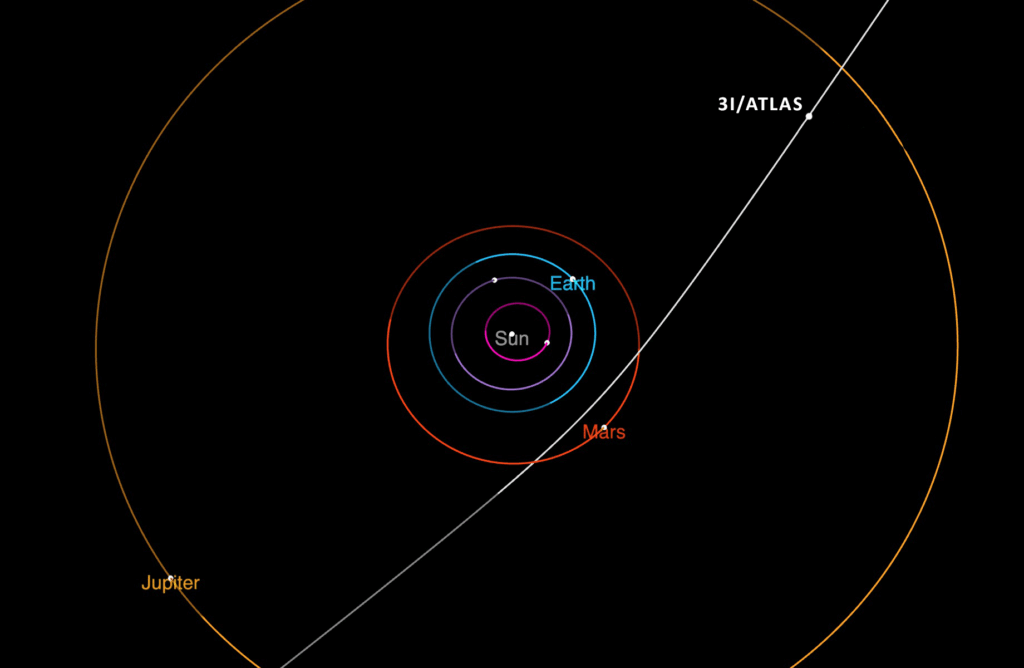
Is It Alien? Addressing The Wild Speculations
With all this attention, it’s no surprise that speculations ran wild in the media. Harvard astrophysicist Avi Loeb raised intriguing questions about whether 3I/ATLAS might be an alien probe or artifact, fueled by unusual brightness variations and strange early signals detected during observations. In social media and popular press, some even dubbed it a “potentially hostile” alien object.
However, leading space scientists and NASA categorically state there is no convincing evidence that 3I/ATLAS is artificial or dangerous. Its orbital path, velocity, and material outgassing all match those expected from natural icy bodies.
Moreover, its distance from Earth never dips below 1.8 AU (about 270 million kilometers), ruling out any impact risk. This cosmic traveler is best understood as a natural but rare visitor from deep space, teaching us more about the universe and not something to fear.
How to Watch 3I/ATLAS Cosmic Visitor in the Night Sky?
For amateur astronomers and enthusiasts eager to see this rare visitor, here’s a detailed how-to guide:
- Best Viewing Window: Late October to early November 2025, before sunrise or just after sunset depending on your location.
- Location in Sky: Near the constellations Libra and Virgo — knowledge of star charts or astronomy apps helps here.
- Equipment: Binoculars won’t cut it; use a telescope with at least a 6-inch aperture for best chances.
- Light Pollution: Find dark skies away from city lights to improve visibility.
- Tracking Tools: Free apps like Stellarium or Sky Guide, and websites like NASA’s comet tracker provide live position updates.
- Professional Monitoring: Telescopes worldwide will continue monitoring it, so online streams and updates might be available for those without gear.
Visibility is fleeting because the comet moves rapidly and grows fainter after perihelion. So don’t miss this incredible chance that won’t come again for decades, if ever.
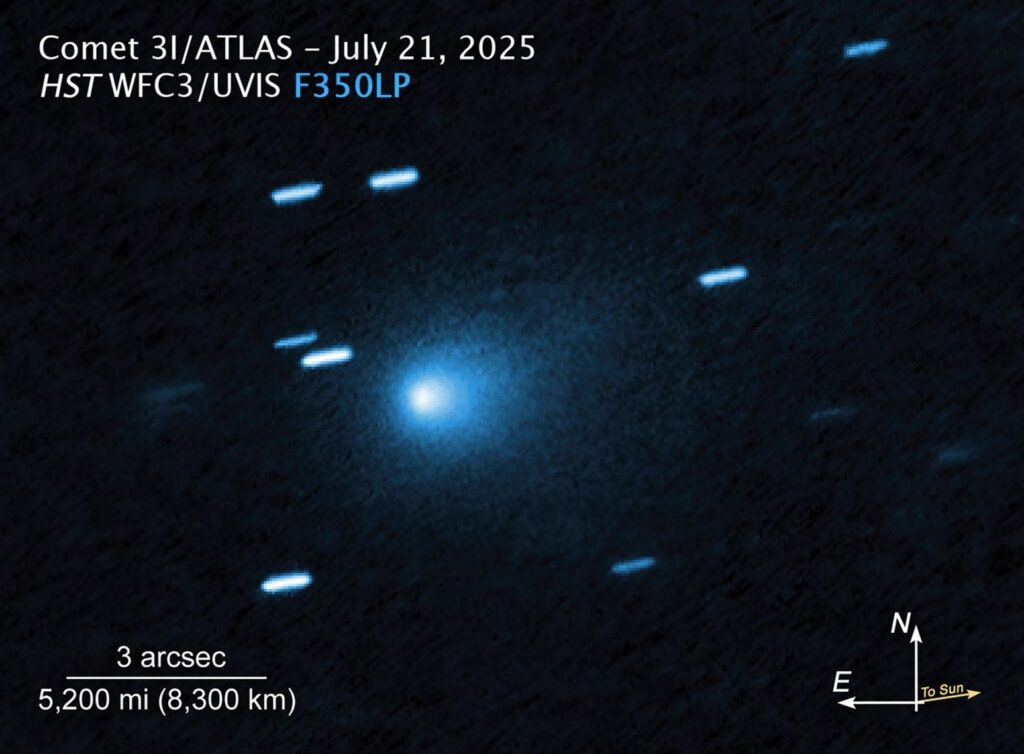
What 3I/ATLAS Is Teaching Us About the Cosmos?
Studying 3I/ATLAS goes beyond just this comet. Scientists treat it like a time capsule or cosmic postcard from a faraway solar system. Understanding its composition and behavior helps:
- Reveal the diversity of organic molecules and ices beyond our Sun’s neighborhood.
- Compare the materials that formed planets and comets in other star systems to our own.
- Provide clues on how planetary systems form and evolve, shedding light on extraterrestrial conditions for life.
Its rich carbon dioxide and water vapor signals tell us interstellar objects might bring unique chemistry to newly forming planetary systems, potentially even seeding organic precursors for life.
The Future: Interstellar Objects and What’s to Come
Looking ahead, 3I/ATLAS has opened eyes to the exciting field of interstellar objects (ISOs), which are likely more common than we knew. Projects like ESA’s Comet Interceptor mission, planned for launch in the coming years, aim to visit such objects up close.
There’s even talk among space agencies and private companies of robotic missions tailored to chase and collect samples from ISOs, bringing back extraterrestrial dust and ices for Earth laboratories—a bold leap for science.
As Earth-based telescopes grow more sensitive and new space observatories come online, scientists anticipate discovering dozens more ISOs, expanding our views of the galaxy.















